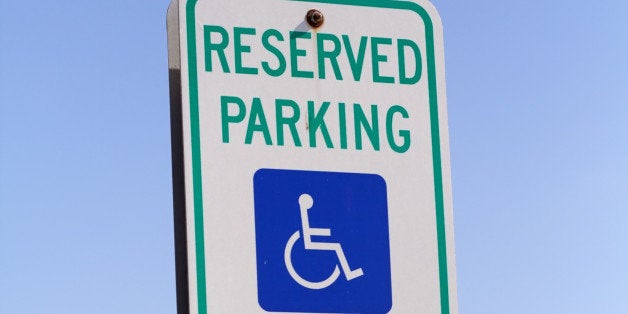
To be honest, I was really hoping that what I'm about to write was common knowledge by now. I really wish that society in general understood disability better, but in light of a number of concerning articles recently, from a USA Today article about people "faking" disability during travel, to a New York Times Magazine article about parents stunting the growth of disabled children through estrogen treatments, it seems necessary to counter the basic inaccurate beliefs people have about disability and those who live with it. Below are a few of the most popular myths, along with suggested reading on each topic.
Myth: If you're in a wheelchair, you can't walk
This week, a USA Today article called out "fakers" who allegedly make up a disability to get special privileges when traveling. In this article, examples include people who are able to stand in a buffet line or in the airport, but are later seen in wheelchairs during priority boarding. The author seemed incredulous that somebody who used a wheelchair could also stand, and accused those who are able to stand of faking a disability.
Truth: You do not have to be paralyzed to need a wheelchair
There are millions of individuals with invisible disabilities in the United States. These disabilities are not immediately apparent, but the pain and other symptoms that come along with them can be extremely debilitating. Take, for example, Multiple Sclerosis. MS is a disease in which the immune system attacks the myelin that covers nerves, damaging the central nervous system. Symptoms include fatigue and mobility issues, and vary from day-to-day and severity. About 400,000 people in the United States and 2.5 million people worldwide have MS. Keep in mind that this is just one invisible disability that can cause someone to need a wheelchair without being paralyzed. There are many other disabilities and diagnoses that can cause chronic pain, fatigue, mobility problems, and other symptoms that necessitate a wheelchair.
Suggested reading: Why Are You Questioning My Need for a Wheelchair? by Beth Griffiths
Myth: Only people with mobility disabilities have an accessible parking placard
On a similar note, we've all seen articles in which someone has left a rude note on the windshield of someone who "doesn't look disabled" but has parked in an accessible parking spot (see examples here, here, and here). The people who leave these notes probably think they are being good Samaritans, protecting those who are "truly in need" from those who borrow grandma's placard. However, they are neglecting, and possibly targeting, those with invisible disabilities.
Truth: There are many conditions beyond visible mobility impairments that necessitate a parking placard
Heart conditions. Postural Orthostatic Tachycardia Syndrome. Lung disease. An amputation that may not immediately be visible. Fibromyalgia. People with invisible disabilities may not "look disabled" to you, but they are. They received the proper documentation from their doctor, and they went through the process to receive a placard. Chances are that when you're calling out someone who "doesn't look disabled" for parking in an accessible space, you are actually targeting somebody who has one of these or many other conditions that qualify them for a placard. You might even cause stress and worry that worsen their symptoms. So, instead of passive aggressively leaving a note on a windshield, leave the policing to police, and understand that the person who just parked in that space and walked out of their car may have challenges that you cannot see.
Suggested reading: Handicap Parking and My Invisible Illness at But You Don't Look Sick
Myth: "Disabled" is a negative word. It's always better to say "person with a disability"
There are a number of resources on people-first language (PFL). The mantra "see the person, not the disability," has become extremely common when talking about disability language. Many people insist that this is the "proper way to talk about disability"--even going as far as correcting the language preferences of the disabled. I have been corrected about saying "disabled" instead of "person with a disability," and I know many others who have received the same criticism.
Truth: Many disabled people prefer identify-first language (IFL)
Within the disability community, there is a popular school of thought called the social model of disability. The social model of disability does not see the group of people known as "disabled" as disabled by their individual impairments (the "medical" part of their disability), but by the fact that society does not consider their differences normal, and therefore does not accommodate them. In this train of thought, someone in a wheelchair is not disabled by not walking. In fact, using a wheelchair is just as natural to them as walking is to those who walk. They are disabled by the fact that a building does not have accessible ramps. The deaf are not disabled by their inability to hear, but by the fact that there is not an interpreter, or there is no closed captioning on a video.
Because of this, many disabled people see themselves as disabled by society. They see their disability as part of their identity, as a fundamental part of their experiences as a person. They do not separate the disability from themselves. It is not something that they carry around; in fact, many see PFL as an erasure of the obstacles they face, just like those who call themselves "colorblind" to race fail to recognize the pervasive societal obstacles to racial minorities.
Anybody has a right to determine their language preferences. Some like PFL, and some like IFL. Their personal preferences should be respected. To correct those who use IFL because they do not separate themselves from disability ignores the fact that they have a very legitimate reason to identify themselves in this way.
Suggested reading: I am Disabled: On Identity-First Versus People-First Language by Cara Liebowitz
Myth: Disabled people are so inspirational. Look how they manage to live with such a burden!
Society largely views the disabled in one of two ways: as objects of inspiration, or as objects of pity. In both cases, the disabled are objects of the (non-disabled) person's viewpoint. This is reflected in feel-good news stories: the football captain invites the disabled girl to prom. The restaurant employee is seen helping a man in a wheelchair eat. It is also reflected in popular memes: one you might be familiar with is the young amputee running on running blades, with the caption "the only disability in life is a bad attitude!"
In the disability community, this is known as Inspiration Porn, a term coined by late disability activist Stella Young in her iconic Ted Talk. The disabled are used as objects of a story to make non-disabled people feel better about their lives or humanity. Most of these stories also fail to interview the disabled person, but will interview other actors, such as the good Samaritan or the disabled person's family. When the disabled say that they don't like these stories, they are often told that they are bitter or ungrateful. After all, someone is being nice to you. Why don't you accept it?
Truth: Disabled people are just people, and want to be treated as such
Inspiration porn is infantilizing and condescending. It is a type of reporting that operates under the assumption that the disabled have lives that are inherently less enjoyable or valuable than non-disabled lives. When they get out of bed in the morning, live a normal life, and do everyday things, they are just so inspiring! This narrative promotes the idea that the disabled are in need of help or encouragement in doing basic tasks, and that people who help them with these tasks, even if they are not asked for their help, are heroes for helping them. However, when it comes to real things that the disabled want to do, such as hold a job or participate in a sport, they are immediately seen as a liability. After all, if it is such an achievement for them to get out of bed every day, how could they possibly perform at the same level of a non-disabled person?
It is true that we should all be kind to each other, and the football captain who invited the disabled girl to prom was doing a nice, innocent thing for a friend. That isn't wrong, as long as it involves actions that are truly wanted by both parties (as opposed to unsolicited and unwanted help or attention). Kindness isn't wrong. What's wrong is that acts of kindness towards the disabled have become a genre of media that reduces disabled people to objects of pity or inspiration in stories that focus on the "heroic" actions of the non-disabled. We don't want that. We want to be recognized as regular people. We want others to understand that our disabilities do not make our lives less valuable or less enjoyable; in fact, many of us take pride in our disabilities. In the words of Stella Young, we are not your inspiration. We are normal people, and we deserve to be treated as such.
Suggested reading: The Making of an Inspiration Porn Star at Crip Novella
